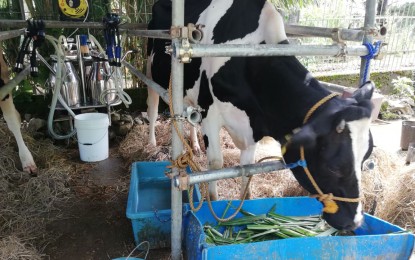
MILKING COW. One of the 49 pregnant cows acquired by the Department of Agriculture in the Cordillera region. With the 49 new cows, the DA-Cordillera is increasing the region’s milk production to achieve commercial quantities, its director, Dr. Cameron Odsey, said Tuesday (Sept. 8, 2020). (PNA photo by Liza T. Agoot)
BAGUIO CITY – The Department of Agriculture is increasing the Cordillera region’s milk production with the acquisition of 49 new cows from Australia.
Director of DA-Cordillera, Dr. Cameron Odsey, said Tuesday they hope to boost the region’s production to commercial quantities with the arrival of the imported pregnant cows at the Baguio Animal Breeding and Research Center.
Odsey said each cow is capable of producing 15 liters to 20 liters of fresh milk daily for a total of about 980 liters for the 49 cows.
He said the new stocks replace the old ones, which have been dispersed to areas in the provinces that are interested in dairy production, such as Sadanga in the Mountain Province and Itogon in Benguet.
As each cow can produce an offspring every year, the region could have about 1,558 cows in five years, if the calves are female and they survive. This would enable the Cordilleras to boost its daily milk production from 1,000 liters at present to 15,680 liters in five years.
Odsey said the new cows are two years old and will be producing milk for 10 years.
He said they would use artificial insemination in impregnating the cows for calf production, using the same genes as that of the imported breed.
“These cows will give birth every year, which we will ultimately disperse to viable areas in the region. Those will be the next generation that will produce milk,” Odsey said.
The offspring, he said, would also be dispersed to interested farmers in nearby provinces as part of the region’s goal to encourage farmers to go into the dairy business aside from farming.
“If we can make this a household enterprise (so) that they can sell to the government (milk) that we can use for the feeding program of the agencies,” Odsey said, noting that they import 99 percent of their milk requirement but the DA is slowly fixing the situation by encouraging people to go into milk production.
He noted that there is no need for wide pastureland in raising cattle.
“A small space will be enough for the cows, so long as there are cut grasses that can be obtained for their food,” Odsey said.
Right now, milk is produced in Baguio, Bauko in the Mountain Province, and Itogon in Benguet.
Sagada in the Mountain Province also produces dairy products from goats that come from the Masferre farm.
The milk is pasteurized, bottled, and sold.
Others buy them fresh for yogurt production. (PNA)
